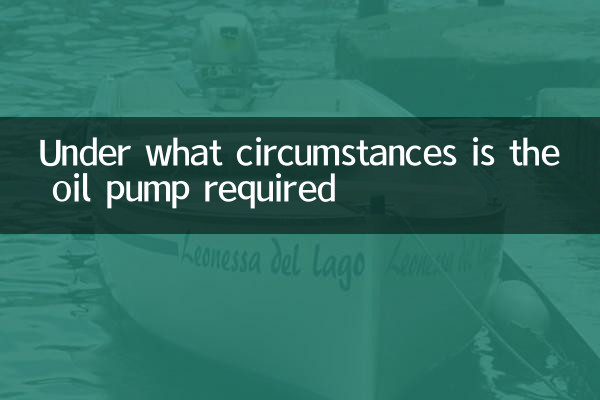Under what circumstances do you need an oil pump? Comprehensive analysis of the timing and importance of oil calibration pump
Oil calibration pumps are a key maintenance project in the fuel system of diesel engines, which directly affect the vehicle's power, economy and emission performance. This article will combine popular topics and hot contents across the network for the past 10 days to structure the common scenarios of oil calibration pumps and provide practical suggestions.
1. Six core scenarios of oil pump

| Scene | Specific performance | Solution |
|---|---|---|
| Power drop | Failure to accelerate, difficulty climbing | Check oil supply pressure of oil pump |
| Abnormal fuel consumption | Fuel consumption per 100 kilometers increased by more than 15% | Calibration fuel injection parameters |
| Exceeding emissions exceed | Extreme black smoke | Adjust the fuel injection advance angle |
| Abnormal engine noise | Metal knocking sound (too premature oil supply) | Recalibration time |
| Difficulty in cold start | -10℃, multiple ignitions are required | Check the plunger seal |
| Regular maintenance | Travel 80,000-100,000 kilometers | Preventive calibration |
2. Hot technical discussion: Modern method of oil pump
In recent industry forums, technical discussions on oil pumps have focused on three aspects:
1.Electronic control VS mechanical oil pump: The electronic control system can directly read data through the OBD interface, while the mechanical pump requires a special pressure gauge to detect (recommended pressure range: 180-220bar).
2.Parts selection: The search volume of plunger parts of a well-known brand has increased by 23% in the past 7 days, reflecting users' attention to original accessories.
3.Repair cost comparison: The pump calibration fee (300-800 yuan) is usually saved by more than 60% compared to replacing a new pump (2000+ yuan).
3. Car owner's actual test data
| Car model | Fuel consumption before pump calibration | Fuel consumption after pump calibration | Improvement range |
|---|---|---|---|
| Dongfeng Truck | 28L/100km | 23L/100km | 17.8% |
| Isuzu pickup | 12.5L/100km | 10.8L/100km | 13.6% |
| Volkswagen Diesel SUV | 9.2L/100km | 8.3L/100km | 9.8% |
4. Operation precautions
1.Professional equipment: The opening pressure must be detected using the injector test bench (standard value: 18-22MPa).
2.Environmental Requirements: It is recommended to operate in a dust-free workshop of 20-25℃. Every change in temperature of 10℃ will affect the 0.1mm plunger gap.
3.Warranty period: High-quality repair points should provide a 3-month or 10,000 kilometers warranty (recent complaint data show that the recurrence rate of roadside stores is 32%).
5. Expert advice
The latest reminder of the China Internal Combustion Engine Association: The National VI emission standard vehicle should test the oil pump every 50,000 kilometers to avoid DPF blockage due to deviation of fuel injection accuracy (more than ±2%). For high-load operating vehicles (such as logistics trucks), it is recommended to shorten the inspection cycle to 30,000 kilometers.
Through the above structured analysis, it can be seen that timely oil calibration pumps can not only restore engine performance, but also a key measure to reduce long-term use costs. When the symptoms listed in the article appear, it is recommended to choose a maintenance agency with CNAS certification for professional calibration.

check the details

check the details